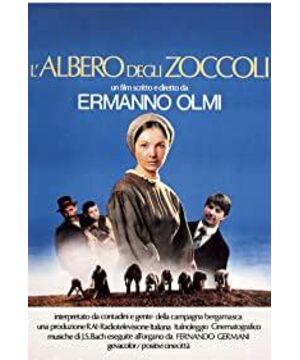This is a unique and authentic rural feature film. Its uniqueness lies in the fact that the author E. Olmi does not deal with the film's plot development according to the theatrical structure of general feature films. He did not combine the narrative center of the story with the characterization, nor did he pay attention to the setting, display and resolution of drama conflicts. Olmi pays more attention to narrating the life process of each family living collectively in a peasant courtyard, their daily joy and pain. The film’s performance in this aspect is true. The author respects the true reproduction of life. Based on this, he has described life scenes in great detail. Therefore, the film has been listed as a masterpiece of "life flow" by European film critics. It definitely makes sense. For example, the scene of slaughtering live pigs, the film almost tirelessly shows one by one from farmers collectively catching pigs, butchers entering the yard, slaughtering pigs, bloodletting, pig splitting, opening, and evisceration. Scenes like this are used to divide them into several important explanatory shots through the omission method in ordinary movies, so as not to give the audience a sense of cumbersome and procrastination. But in the film "Wooden Clogs", the author expresses this in the whole process, so that the audience's aesthetic sense can focus on the authenticity of the pig slaughter flow. Another example is the scene where Minek's clogs broke and he could not repair himself and then walked home barefoot, but also described this not short scene in the whole process. Like the scene of pig slaughter, the audience grabs the essence of aesthetics from the authenticity of the details, and is not bored. On the contrary, they have a deep sympathy for the child Minek.
In this sense, Olmi actually intends to break through the conflict theory that is common in Western film dramas that advocates representing the collision of two forces, but to let life itself reflect the existence and connotation of this opposition and collision. Therefore, it cannot be considered that the film is purely a cumbersome reproduction of the life of a peasant family. The author intends to reflect his love for farmers through detailed and true depictions of the different destinies of some peasant families.
Of course, we cannot say that "The Tree of Clogs" is a "live stream" film in general, because the author does not adopt a purely objective attitude towards life. According to general understanding, "Lifestream" movies strongly advocate direct shooting of life facts and events that enter the camera's field of vision, without making choices or making evaluations, forming a true expression of "objectification", allowing the audience to grab their own aesthetic feelings. However, "The Wooden Clogs Tree" clearly made a creative choice. First of all, the author chose several farmhouses: For example, Batisti is a strong middle-aged farmer who is hardworking, capable, loves family, and loves children. In the end, he was expelled by the landlord because of the children; the widow led her husband and children to live. The unfortunate illness of the livestock reminded her of the assistance of the Virgin Mary; Bruno had no antagonistic hatred with his children, but in order to educate his son to work, he even beat him like an enemy; It is a young female worker. After getting married, she saw the misfortune of urban residents and adopted an abandoned baby regardless of prejudice. None of these people are true models, but A. Olmi takes this as a different representative of the peasant class. They are all fighting against the same social forces to improve their lives. After E. Olmi made this choice, he actually summarized their struggle. Batisti was expelled from the manor, and the widow’s sick cow was healed, but he did not understand the real reason. Bruno seemed to Understand that stick beating is not necessarily the best method of education. In fact, the author of the film is pinning his hopes on Stefani and her new husband, because they have shown a kind of deeds and strength, and they have adopted an outcast, E. Orr, despite all possible prejudices. Mi also did not regard their actions as the result of emotional impulse, but instead wrote them as a kind of sensible behavior after witnessing the same difficulties in city life.
When Ai Olmi presents the details of rural life in isolation, he connects this life to the outside world, especially to some little-known events or phenomena in the city. Therefore, Stefani's attitude towards life is also the hope of director E. Olmi for life.
Ai Olmi did not treat "The Clog Tree" as a general "stream of life" film. Because "lifestream" films are generally limited to "collecting" the "immediate performance" of life, and do not pay too much attention to its internal connections from the perspective of theatrical structure, "lifestream" films are content to be connected together according to the prototype of life. Sometimes even a kind of messy connection is used under the requirement of authenticity, so that the film has only fragmented logic programs without overall coherence. But in "The Tree of Wooden Clogs", the author does not pay attention to the obvious relationship between too many "individuals" and society, but emphasizes the "family", that is, the daily life of the group. It is through the natural and real life details that the author makes people feel that the group is enduring social exploitation, rather than a certain person or a certain family; they are acting as a class, thus making people feel that the film is objectively It expresses the profound sociality behind the ordinary life scene.
View more about The Tree of Wooden Clogs reviews







